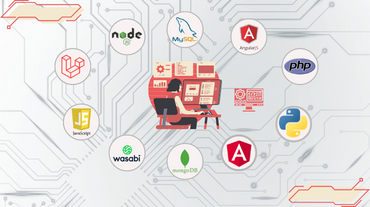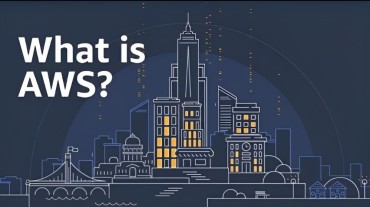What is Full Stack Development?
The complete development of a web application from start to finish from designing to testing is Full Stack Development. A full-stack developer is responsible for building and maintaining the entire application, from the user interface to the server-side logic and database interactions.
The front-end development involves designing and developing the user interface that users interact with such as React Native, ReactJS, JQuery, JSON, AJAX, HTML, CSS, and JavaScript. This includes creating responsive and user-friendly web pages, and ensuring that they work seamlessly across multiple devices and browsers.
The back-end development involves building the server-side logic that handles data storage, retrieval, and processing. This includes writing code to interact with databases, building APIs (Application Programming Interfaces), and handling user authentication and authorization.
Full-stack developers are proficient in a variety of programming languages and frameworks. They have a good understanding of software architecture and database design, as well as experience working with web servers and cloud infrastructure.
There are some Front End like React Native that we work with…
React Native is a JavaScript framework for building native mobile applications for iOS and Android. The same code can be used for both iOS and Android, thereby reducing development time and cost. It is easy to build and maintain complex user interfaces using React Native.
ReactJS is a popular is a free and open-source front-end JavaScript library for building user interfaces. It is easy to build and update complex UI components using ReactJS. It is commonly used for building single-page applications and can be used with other technologies like Redux for state management.
JQuery is a JavaScript library that simplifies common tasks like event handling and AJAX (Asynchronous JavaScript and XML). It is easy to write cross-browser JavaScript code. JQuery is commonly used for adding interactivity and dynamic content to web pages.
JSON (JavaScript Object Notation) is a lightweight data interchange format that is easy to read and write, and easy for machines to parse and generate. It is commonly used for transmitting data between a web application and a server, and is often used with AJAX to dynamically update content on a web page without requiring a full page reload.
With the use of AJAX the web pages can be updated dynamically . AJAX uses JavaScript to make the request and process the response, and is commonly used with JSON for transmitting data between a web application and a server. AJAX is used in combination with JQuery to simplify the process of making HTTP requests and handling responses.
Likewise we have few Back End technologies that is currently in use are…
PHP is a popular server-side scripting language used for web development. It is open source and widely supported, making it a popular choice for building dynamic websites and web applications. PHP is commonly used in conjunction databases and can be used to generate dynamic content, handle form submissions, and process user authentication and authorization.
Laravel is a PHP web application framework that provides a range of tools and libraries for building scalable and maintainable web applications. It follows the Model-View-Controller (MVC) architectural pattern and provides features like routing, middleware, and Eloquent ORM for interacting with databases.
Python is widely used in web development. It has a large and active community of developers and provides a range of web frameworks for building web applications. Python frameworks like Django and Flask provide features like routing, database integration, and user authentication and authorization.
Dot Net or as we call it .NET is a framework developed by Microsoft for building web applications and other types of software. It provides a range of tools and libraries for building scalable and secure web applications. The .NET framework includes languages like C# and VB.NET, and provides features like ASP.NET for web development.
Java is a widely used programming language for web development. It is platform-independent and provides a range of web frameworks like Spring and Struts for building web applications. Java frameworks provide features like dependency injection, object-relational mapping, and user authentication and authorization. Java web applications can be deployed on a range of servers like Apache Tomcat, JBoss, or IBM WebSphere.
There is another aspect of technology for data storage called Databases which encapsulates….
In full-stack development, both MongoDB and SQL databases can be used as a backend data storage solution, depending on the specific needs of the application being developed.
MongoDB is a popular choice for web applications that require high scalability and flexibility, as it allows for easy horizontal scaling and has a flexible schema. This makes it well-suited for use cases such as e-commerce websites that handle a large number of transactions or social media platforms that require fast data retrieval.
SQL databases, on the other hand, are widely used in enterprise applications where data consistency and reliability are critical. SQL databases provide a strong schema that ensures data consistency, which is essential for applications that deal with sensitive information like financial data or healthcare records.
When it comes to choosing a database for a full-stack application, developers must consider the specific requirements of the application, including the data schema, scalability needs, and expected data volume. It is important to ensure that proper database design and management practices are followed to ensure optimal performance and data security.
Cloud services is another aspect of technology, where we have Cloud services like AWS and Azure popular in full-stack development. They provide a range of tools and services that make it easier to develop, deploy, and manage web applications. AWS and Azure are both cloud computing platforms that provide a range of services, including computing, storage, and networking, as well as a range of tools and services for developers.
AWS and Azure can be used to host the application stack, providing a scalable and reliable infrastructure for the application. They can also be used to deploy and manage applications, as well as to automate infrastructure and application management tasks.
AWS provides a range of services for full-stack development, including AWS Elastic Beanstalk, AWS Lambda, and AWS EC2. Azure provides similar services to AWS, including Azure App Service, Azure Functions, and Azure Virtual Machines. App Service is a fully managed service that makes it easy to deploy and manage web applications, while Functions is a serverless computing service similar to AWS Lambda. Virtual Machines provide virtual servers in the cloud, which can be used to host web applications.
AWS and Azure also provide a range of tools and services for developers, including databases, messaging, and analytics services. These services can be used to enhance the functionality and performance of web applications, as well as to provide insights into application usage and performance.


